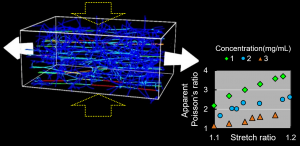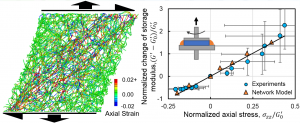
(L) stretched fiber network models exhibit large contractions in the transverse direction. This effect is accompanied by the buckling of thin fibers oriented transverse to the direction of loading. (R) Apparent Poisson’s ratio increases with stretch and decreasing collagen concentration. Concentrations of 1, 2, and 3 mg/mL were tested.
Shenoy group in the IRG led a study on the multiaxial behavior of collagen networks. When stretched, the network models exhibited drastic contractions transverse to the direction of loading (yellow arrows in the top left image). The networks exhibited an anomalous Poisson effect, with apparent Poisson’s ratios larger than 1. Experiments validated this result and showed increases of apparent Poisson’s ratio with decreasing collagen concentration (top right image).

(L) Snapshot of a network model tested by a combination of axial and shear loading. Fiber stretching is observed along the elongated diagonal of the matrix, which coincides with the maximum principal stretch direction. (R) The network shear modulus increases and decreases linearly with increasing and decreasing normal stress, respectively. The inset displays a schematic of the axial-shear rheometry experiments.
Janmey lab in the IRG used rheometry to study the behavior of collagen networks in combined axial and shear loading. The networks exhibited a linear variation of network shear stiffness with normal stresses (bottom right image). This result agreed with the behavior of the network model from Shenoy group (bottom left image). The results of this study were published in the Proceedings of the National Academy of Sciences of the USA.
- Ban, H. Wang, J. M. Franklin, J. T. Liphardt, P. A. Janmey, and V. B. Shenoy, Strong Triaxial Coupling and Anomalous Poisson Effect in Collagen Networks, Proc. Natl. Acad. Sci. U. S. A. (2019)
